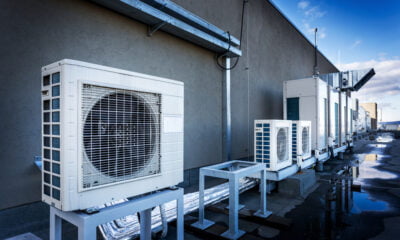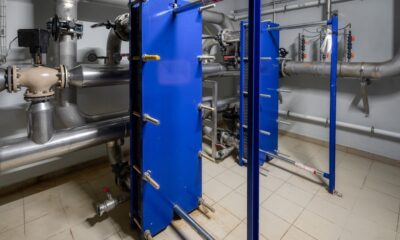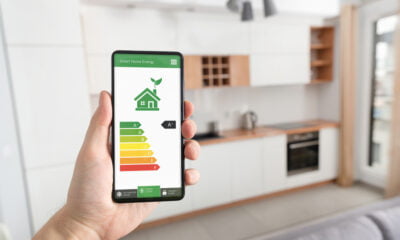

Energy
Anatomy of an Energy Efficient Home
There are dozens of simple little things you can start doing in your day-to-day life that, when done consistently over time, can mean a huge difference to the future of our environment … and there’s no better place to start than in your very own home. With just a few adjustments and additions, you can make your home much more energy-efficient. And while installing and implementing these changes may cost you a little extra up front, in the long run you’ll be saving hundreds on your energy bill.

Anatomy of an Energy Efficient Home created by Homes.com
You can begin your energy-efficient upgrades in the garage. There are lots of awesome energy-efficient cars on the market right now, like the Toyota Prius, the Nissan Leaf and the Honda Fit. Hybrid vehicles can reduce smog-forming pollutants by up to 90 percent and cut emissions of carbon dioxide in half, meaning every time you hit the road, you’re doing a huge favor for the environment. You will have to install a charging station, which will will cost you about $500, but it will be worth it in the long run. Driving an electric car won’t just cut down on carbon dioxide; it can also save you an average of $5,000 in gas money over five years of ownership.
Moving into your home, there are tons of changes you can start making, but the one thing that should be on your mind the entire time is “Energy Star.” Energy Star is an internationally used rating system that lets you know that the product or appliance you’ve got uses 20% to 30% less energy than required by federal standards. If you’re buying any new appliance, chances are you can get one with an Energy Star rating. In the kitchen, for instance, an Energy Star fridge runs 9% to 10% more efficiently than a standard model and can save you up to $300 over its lifetime. An Energy Star dishwasher will save 10,000 gallons of water over its lifespan, cutting $32 a year from your water bill.
Most electronics for work and entertainment can also be found with Energy Star ratings. Energy Star-rated Blu-ray players and televisions run 25% more efficiently than normal ones and can save you $200 over the lifespan of the product. An Energy Star-rated laptop also runs 25% more efficiently than normal ones and will save you $35 annually if you have the unfortunate tendency of keeping your laptop running all the time (which we really recommend against!). Heating and cooling your house can also be granted Energy Star upgrades with rated air conditioners and furnaces. An energy-efficient furnace uses one-third the electricity of a regular furnace and can save you 22%. Energy Star-certified air conditioners use 8% less energy than conventional models and can save you thousands over the lifespan of the product.
Another term that can save you money and energy all over the house is “low flow.” Low-flow faucets and showerheads can be installed in any sink or shower to cut down on the amount of water you use every day. They work by decreasing the amount of water that comes out of the faucet but increasing the amount of pressure applied to that water, so people don’t notice the overall loss in water volume. A standard showerhead uses about 3.33 gallons of water per minute, which means a typical 10-minute shower will use about 33 gallons of water. A low-flow showerhead only uses 2 gallons of water per minute, which means you’re saving about 13 gallons of water every shower. Depending on how many showers you take, that could save up to 6,500 gallons of water a year and trim 43% off your hot water bill. The same applies to sink faucets in your kitchen and bathrooms. Low-flow sink heads use 32% less water than normal ones and can save you up to $92 a year on your water bill. Low-flow toilets use 1 gallon of water per flush as opposed to a normal toilet’s 5 gallons per flush, which can also save you up to 40% on your water bill.
Finding new ways to regulate your home’s temperature can also lead to new ways to lower your energy bill. A programmable thermostat will adjust the temperature in your house for you and can save you 10% annually on your heating bill. Some of the best ones on the market include the Nest, the Ecobee 3 and the Honeywell Lyric. In addition, a tankless water heater uses 30% less energy than a normal one and can save you up to $100 a year on your water bill. But there are also some old-fashioned, low-tech additions that will increase your home’s energy efficiency. Weather-stripping your windows will keep heat from getting out and lower your heating bills 10% to 15% a year. A ceiling fan only uses 2% of the energy an air conditioner does and could save you hundreds on your bill annually. You can even make your bed more environmentally friendly with some energy-efficient bedding. A down comforter will keep you warmer on cold nights, meaning you don’t have to turn the heat way up. Plus it’s cozy!
These changes, while seemingly insignificant, will have you sucking up less energy and producing less waste. You may not win a Nobel Prize for it, but the environment will be thankful for your actions all the same. The little changes we make today can mean the difference between giving future generations a healthy planet and a diseased one on the brink of destruction. So next time you enter your home, take a look around; you’ll probably see a dozen different ways you can start saving the world right now.
Sources:
http://energy.gov/energysaver/tips-kitchen-appliances
http://www.thisoldhouse.com/toh/photos/0,,20441/335,00.html
http://www.livescience.com/40553-lightbulbs-incandescent-fluorescent-led-infographic.html
http://www.thesimpledollar.com/ceiling-fan-hacks-save-big-on-energy-use/
https://www.rinnai.us/tankless-water-heater/energy-savings
http://solarenergy.net/energy-saving/solar-energy-savings/
http://programmable-thermostats-review.toptenreviews.com/






























